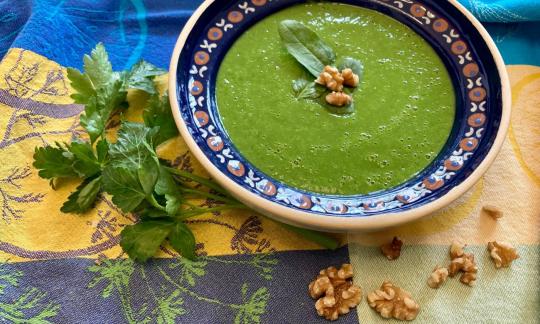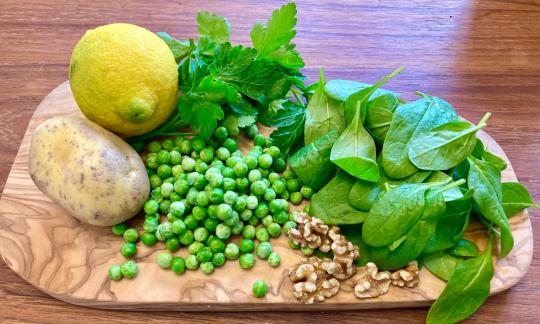Green pea soup with leaf spinach, parsley and walnut
vegan
Ingredients (for servings, )
| For the soup base | |
|---|---|
| 21 oz | Peas, green, frozen, untreated (organic?) |
| Optional | |
| 1 | Potatoes, raw (organic?) (3.2 oz) |
| remaining ingredients | |
| 600 ml | Drinking water, raw (organic?) (21 oz) |
| 5 ½ oz | Spinach, raw (vegetable spinach) |
| ½ oz | Parsley, fresh, raw (leaf parsley, parsley) |
| 1 dash | Table salt (table salt, raw?, organic?) (0.01 oz) |
| 1 dash | Black pepper (organic?, raw?) (0.00 oz) |
| ½ | Lemons, raw (limes, organic?) (1.0 oz) |
| For the topping | |
| ⅔ oz | Walnuts (tree nuts), raw (organic?) |
Equipment
- blender or hand-held blender / immersion blender
- vegetable peeler
- stove
- saucepan
Type of preparation
- cook
- chop or grind
- purée
- peel
Preparation
Preparing vegetables
Peel the potatoes and cut them into small cubes. Put them in a pot with the peas and water and bring to the boil. Simmer for about 5-8 minutes until the potatoes and peas are cooked. If you leave out the potatoes, the cooking time is reduced to about 5 minutes.The use of potatoes is optional. They give the dish more creaminess. But even without potatoes, this dish tastes very good and has a richer green color.
If you have fresh peas available, these are preferable. Pre-cooked peas that are available in jars or cans are not suitable.
Finishing the pea soup
Add the spinach and parsley and puree using a hand blender or gradually in a blender. Season with a little salt (optional), pepper and a squeeze of lemon and add water depending on the desired consistency.Serve in soup bowls with chopped walnuts as a topping.
Chopping nuts: You can wrap the nuts in a cloth and work them with a solid object (e.g. hammer) on a solid surface.
|
Nutritional Information per person
Convert per 100g
|
2000 kcal | |
|---|---|---|
| Energy | 178 kcal | 8.9% |
| Fat/Lipids | 4.1 g | 5.8% |
| Saturated Fats | 0.44 g | 2.2% |
| Carbohydrates (inc.dietary fiber) | 27 g | 10.1% |
| Sugars | 8.2 g | 9.1% |
| Fiber | 8.7 g | 34.9% |
| Protein/Albumin | 10 g | 20.6% |
| Cooking Salt (Na:240.1 mg) | 610 mg | 25.4% |
| Essential micronutrients with the highest proportions | per person | 2000 kcal | |
|---|---|---|---|
| Vit | Vitamin K | 241 µg | 321.0% |
| Vit | Folate, as the active form of folic acid (née vitamin B9 and | 167 µg | 84.0% |
| Vit | Vitamin C (ascorbic acid) | 51 mg | 64.0% |
| Min | Manganese, Mn | 1.1 mg | 53.0% |
| Vit | Vitamin A, as RAE | 346 µg | 43.0% |
| Vit | Thiamine (vitamin B1) | 0.46 mg | 42.0% |
| Prot | Threonine (Thr, T) | 0.39 g | 42.0% |
| Min | Copper, Cu | 0.36 mg | 36.0% |
| Prot | Tryptophan (Trp, W) | 0.08 g | 34.0% |
| Prot | Isoleucine (Ile, I) | 0.39 g | 31.0% |
Detailed Nutritional Information per Person for this Recipe
The majority of the nutritional information comes from the USDA (US Department of Agriculture). This means that the information for natural products is often incomplete or only given within broader categories, whereas in most cases products made from these have more complete information displayed.
If we take flaxseed, for example, the important essential amino acid ALA (omega-3) is only included in an overarching category whereas for flaxseed oil ALA is listed specifically. In time, we will be able to change this, but it will require a lot of work. An “i” appears behind ingredients that have been adjusted and an explanation appears when you hover over this symbol.
For Erb Muesli, the original calculations resulted in 48 % of the daily requirement of ALA — but with the correction, we see that the muesli actually covers >100 % of the necessary recommendation for the omega-3 fatty acid ALA. Our goal is to eventually be able to compare the nutritional value of our recipes with those that are used in conventional western lifestyles.
| Essential fatty acids | per person | 2000 kcal |
|---|---|---|
| Alpha-Linolenic acid; ALA; 18:3 omega-3 | 0.56 g | 28.0% |
| Linoleic acid; LA; 18:2 omega-6 | 2.1 g | 21.0% |
| Essential amino acids | per person | 2000 kcal |
|---|---|---|
| Threonine (Thr, T) | 0.39 g | 42.0% |
| Tryptophan (Trp, W) | 0.08 g | 34.0% |
| Isoleucine (Ile, I) | 0.39 g | 31.0% |
| Lysine (Lys, K) | 0.58 g | 31.0% |
| Valine (Val, V) | 0.47 g | 29.0% |
| Leucine (Leu, L) | 0.64 g | 26.0% |
| Phenylalanine (Phe, F) | 0.40 g | 26.0% |
| Methionine (Met, M) | 0.16 g | 17.0% |
| Vitamins | per person | 2000 kcal |
|---|---|---|
| Vitamin K | 241 µg | 321.0% |
| Folate, as the active form of folic acid (née vitamin B9 and | 167 µg | 84.0% |
| Vitamin C (ascorbic acid) | 51 mg | 64.0% |
| Vitamin A, as RAE | 346 µg | 43.0% |
| Thiamine (vitamin B1) | 0.46 mg | 42.0% |
| Biotin (ex vitamin B7, H) | 13 µg | 25.0% |
| Vitamin B6 (pyridoxine) | 0.30 mg | 22.0% |
| Niacin (née vitamin B3) | 3.2 mg | 20.0% |
| Riboflavin (vitamin B2) | 0.24 mg | 17.0% |
| Pantothenic acid (vitamin B5) | 0.97 mg | 16.0% |
| Vitamin E, as a-TEs | 0.87 mg | 7.0% |
| Essential macroelements (macronutrients) | per person | 2000 kcal |
|---|---|---|
| Sodium, Na | 240 mg | 30.0% |
| Potassium, K | 588 mg | 29.0% |
| Phosphorus, P | 175 mg | 25.0% |
| Magnesium, Mg | 86 mg | 23.0% |
| Calcium, Ca | 89 mg | 11.0% |
| Essential trace elements (micronutrients) | per person | 2000 kcal |
|---|---|---|
| Manganese, Mn | 1.1 mg | 53.0% |
| Copper, Cu | 0.36 mg | 36.0% |
| Iron, Fe | 3.9 mg | 28.0% |
| Zinc, Zn | 1.7 mg | 17.0% |
| Iod, I (Jod, J) | 12 µg | 8.0% |
| Selenium, Se | 3.6 µg | 7.0% |
| Fluorine, F | 107 µg | 3.0% |
The green pea soup with leaf spinach, parsley and walnuts is easy to make and does not require any oil. Potatoes give the dish more creaminess.
Nutrient profile: According to GDA guidelines, one portion of this recipe covers more than three times the recommended daily requirement of vitamin K, which plays an important role in blood clotting and bone metabolism. Folic acid is covered by over 75% and vitamin C by over 50%. The ratio of omega-6 to omega-3 fatty acids is 4:1, which is within the recommended ratio.
You can find out more at the following link: Vegans often eat unhealthily. Avoidable nutritional errors .
Peas: The pea ( Pisum sativum) belongs to the Faboideae subfamily and contains a lot of protein and carbohydrates. Thanks to its protein content, this crop, which originally comes from Asia Minor, is also used in many animal feeds. Fresh green peas have firm, round pods. With fresh peas, the peas inside the pod must be removed before they can be eaten and the pods must be thrown away. Green peas taste sweet and are crunchy. They can be eaten raw or cooked. If you let them ripen further or do not use them quickly after harvesting, they will have a starchy, floury consistency.
Spinach: Spinach is rich in vitamins (especially β-carotene, vitamin C), protein and minerals. Although spinach has a high iron content among vegetables, the iron content is not exceptionally high. Despite the high oxalic acid content, consuming raw spinach in reasonable amounts is not harmful to health.
Parsley: Using fresh parsley is a great way to add some extra flavor to your dishes. Parsley is a source of flavonoids, antioxidants and vitamins, especially vitamins K, C and A, making this culinary herb suitable for more than just a garnish.
Walnuts: In addition to preparing and refining various dishes and desserts, walnuts are also used to make walnut oil. Of all known nuts, walnuts have the highest proportion of alpha-linolenic acid. They also have health benefits thanks to their high levels of tocopherols (forms of vitamin E) and many other trace elements.
Reduce salt and oil: We have consciously reduced the amount of salt and left out oil completely for health reasons. You can find more information on this topic in the book we describe in detail: "Salt Sugar Fat" by Michael Moss.
Chopping nuts: You can wrap the nuts in a cloth and work them with a solid object (e.g. hammer) on a solid surface.
Fresh peas: If you have fresh peas available, these are preferable. But frozen peas are also suitable for this dish. Pre-cooked peas that are available in jars or cans are not suitable.






